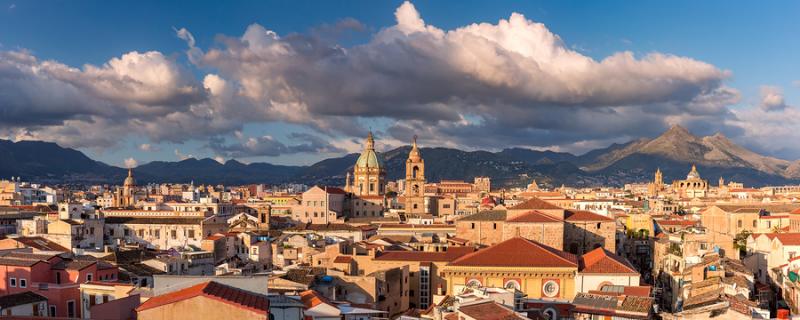One of the most fascinating cities in Italy, with a thousand-years-old history, a historic center rich with churches and palaces, and a cuisine and street food scene to remember, Palermo makes for a perfect weekend break, easily reached by air from mainland Italy and Europe.
Here are five things you should see and do when visiting Palermo.
Start at Quattro Canti
The so-called ‘Quattro Canti’ represents the heart of Palermo. It is a Baroque square, laid out by the Viceroys between 1608-1620 at the crossing of the city’s two main streets: Via Maqueda and Corso Vittorio Emanuele. They divide the city into the four neighborhoods of Palazzo Reale, Monte di Pietà, Castellamare and Tribunali.

The piazza is octagonal, with four sides taken up by the streets, and the other four by Baroque buildings. Their near-identical facades contain fountains with statues of the four seasons, the four Spanish kings of Sicily and the four patronesses of Palermo (Christina, Ninfa, Olivia and Agata).
Quattro Canti, officially known as Piazza Vigliena, could be the starting point of your Palermo itinerary.
Visit the Cathedral of Palermo
The symbol of the Sicilian capital, the Cathedral was built in 1184 by the Anglo-Norman Archbishop of Palermo, Gualtiero Offamilio, in honor of the Assumption of the Virgin Mary. It is a Unesco World Heritage Site, together with the cathedrals of Cefalù and Monreale as part of the Arab-Norman Palermo site.
Don’t limit yourself to the basilica, visit the entire monumental area (entry fee) and see: the royal tombs with the remains of Frederick II, King of Sicily from 1198 and Holy Roman Emperor from 1220, his father Henry VI, his mother Costanza D'Altavilla, his grandfather Roger II, founder of the Kingdom of Sicily; the Treasury of the Cathedral, featuring sacred vestments from the 16th and 18th centuries, and the imperial crown found in the tomb of Constance of Aragon, Queen of Germany and Sicily and Holy Roman Empress; the crypts with the tombs of the Archbishops of Palermo; the Roofs, where you can understand the history of the interventions carried out on the Cathedral complex and admire great panoramic views of the city.
Admire the Fontana Pretoria
In the heart of the historic center, the Pretoria Fountain, considered one of the most beautiful in Italy, was originally built for the garden of don Luigi de Toledo in Florence in 1554, but moved to Piazza Pretoria in Palermo in 1581. It’s nicknamed ‘Fountain of Shame’ because of the nudity of the statues that compose it.
Initially, the work included 48 statues of mythological figures and cherubs. When Luigi de Toledo died, indebted, his son put it up for sale; the Palermo Senate bought it and, in order to transport it, disassembled it into 664 pieces. However, during transport by ship, some of its parts broke, so some interventions were needed to reconstruct the pieces.

Paying attention to the arrangement of the statues, you can perceive a tension towards the center of the fountain and a sense of movement.
Piazza Pretoria has long been considered by Palermo citizens to be the symbol of the corruption and malpractice of local politicians in the 18th and 19th centuries, hence the double meaning of the ‘Fountain of Shame’.
Catch a show at Teatro Massimo
The Teatro Massimo is the largest opera theater in Italy and the third in Europe after the Opéra National in Paris and the Vienna State Opera.
The idea of building a opera house that would be worthy of the second biggest city in southern Italy (after Naples) came in 1864, when Palermo’s mayor announced an international competition for the construction of a large theater that would to promote the image of the city following the unification of Italy in 1861. The Teatro Massimo was completed in 1897 and dedicated to King of Italy Victor Emanuel II.

The exterior was designed in neoclassical style incorporating elements of the Greek temples at Selinunte and Agrigento.
Fun fact: the final scenes of the film The Godfather Part III were filmed at the Teatro Massimo.
Visit inside and buy a ticket for one of its shows.
Eat Sicilian Cannoli
Cannoli, a staple of Sicilian (and Italian-American) cuisine, are among the most famous Italian pastries. They consist of tube-shaped shells of fried pastry dough, filled with a sweet, creamy filling of sheep’s milk ricotta, decorated with candied fruit and chocolate chips. They range in size from ‘cannulicchi’, small as a finger, to a larger, fist-sized version typically found south of Palermo, in Piana degli Albanesi.
Cannoli originated in Palermo and Messina, where they were prepared as a Carnival treat, and possibly as a fertility symbol. The dessert eventually became a year-round staple in Sicily.

According to legend, the cannolo was born in the Monastery of the Badia Nuova of Palermo as a consequence of a carnival joke carried out by nuns against a priest: the nuns let out ricotta from a tap, in Sicilian ‘cannolo’. In reality, it’s more likely that the name derives from the custom of frying the shells inside river canes (canna in Italian), from which cannolo takes its unmistakable shape.
In Palermo, ricotta is never mixed with cream or milk cream, as is customary in other parts of Sicily.
Why not eat cannoli while strolling the streets of Palermo, as is done for a lot of the city’s famous street food.








